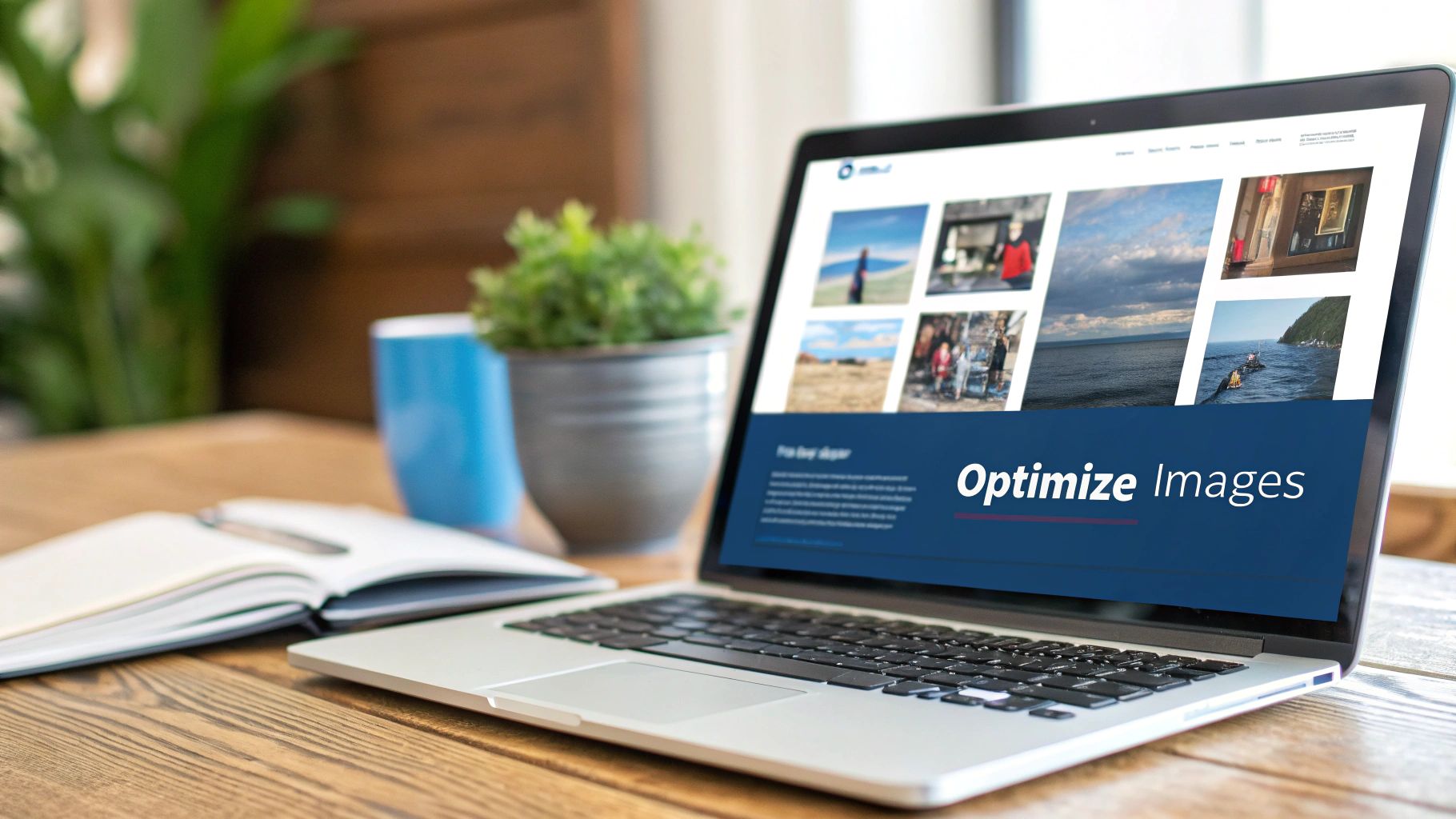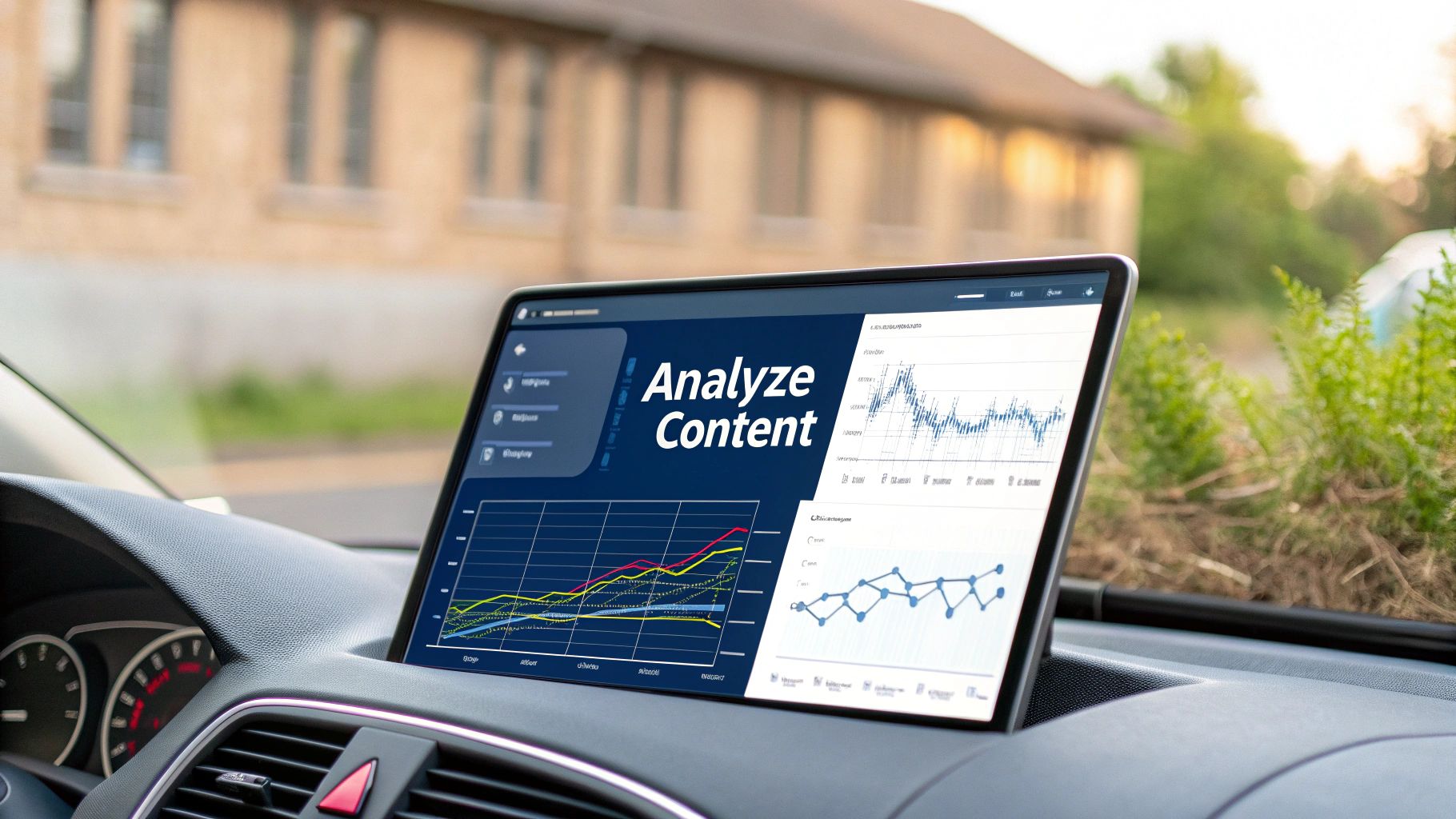How to Optimize Website Speed: A Step-By-Step Guide for Digital Success
Understanding the Business Impact of Speed

Website speed directly affects your company's success and bottom line. When your site loads slowly, you lose visitors and sales. Research shows that just one extra second of load time reduces page views by 11% and conversions by 7%. These aren't just numbers – they represent real customers and revenue slipping away. Let's look at exactly how site speed impacts different aspects of your business and what it means for your growth.
The Financial Impact of Slow Websites
Slow websites cost companies real money. Here's a clear example: A site that loads in one second typically gets around 30.5 sales per 1,000 visitors. When that same site takes five seconds to load, sales drop dramatically to just 10.8 per 1,000 visitors. The math is simple – slower sites mean fewer sales. For retail companies, slow page loads add up to $2.6 billion in lost revenue each year. This shows why investing in faster load times is crucial for protecting and growing your business.
How Speed Influences User Behavior
People have little patience for slow websites. The data tells a clear story: 40% of desktop users and 53% of mobile users will leave a site that takes over three seconds to load. This high abandonment rate directly hurts your site's performance in search rankings. Sites loading in 1-2 seconds see bounce rates around 9%. When load time increases to five seconds, bounce rates jump to 38%. These numbers show how quickly users make decisions about staying on or leaving your site based on its speed.
The Importance of Speed for Mobile Users
With over half of web searches now happening on phones and tablets, mobile speed is essential. Mobile pages typically load much slower than desktop – 8.6 seconds compared to 2.8 seconds on desktop. This gap matters because Google now ranks sites based heavily on mobile performance. Slow mobile sites not only frustrate users but also rank lower in search results. The impact on business is clear: B2B sites that load in one second see conversion rates five times higher than those taking 10 seconds. For companies wanting to succeed on mobile, fast load times aren't optional – they're necessary for staying competitive and growing your business.
Making Core Web Vitals Work for You
Website speed is about more than just fast loading – it's about creating a smooth, responsive experience that keeps visitors engaged. Google measures this through Core Web Vitals, which look at how quickly content loads, how responsive pages are, and how stable they remain while loading. Getting these metrics right helps both your search rankings and visitor satisfaction. Let's look at what these metrics mean and how to improve them.
The Three Key Core Web Vitals
The Core Web Vitals focus on three distinct aspects of user experience: loading speed, interactivity, and visual stability. Each metric tells us something different about how visitors experience your site. Take loading speed – measured by Largest Contentful Paint (LCP). When visitors land on your page, they want to see the main content quickly, not stare at a blank screen.
- Largest Contentful Paint (LCP): This tracks how fast your largest content element (like a hero image or headline) appears on screen. You want this under 2.5 seconds. Think of LCP like serving the main course at a restaurant – guests shouldn't have to wait too long for the star of the show.
- First Input Delay (FID): This measures how quickly your site responds when users click or tap. Aim for under 100 milliseconds. It's like a conversation – you want immediate responses, not awkward pauses. Nobody likes clicking a button and wondering if it worked.
- Cumulative Layout Shift (CLS): This shows how much your page elements jump around while loading. Keep it under 0.1. Have you ever tried clicking something only to have it shift at the last second? That's exactly what CLS prevents – those frustrating content jumps that lead to accidental clicks.
Making Your Core Web Vitals Better
Improving these metrics takes focused work on several fronts. For better LCP scores, start with image optimization. Using compressed images in modern formats like WebP can slash load times while keeping images crisp. Clean up your code too – remove unused JavaScript, minimize CSS files, and enable browser caching. This helps both LCP and FID by reducing what the browser needs to process.
FID improvements often come from smart resource loading. Use a service worker to pre-cache critical resources and delay loading non-essential scripts until after the page is interactive. For CLS, the key is structure – give your images and ad spaces set dimensions so content doesn't shift as elements load in.
You don't have to guess at what's working. Tools like PageSpeed Insights, Lighthouse, and Chrome DevTools show exactly where you need to focus. They provide clear scores and specific suggestions for improvements. Follow their recommendations systematically and you'll see better performance, happier visitors, and improved conversion rates.
Mastering Modern Image Optimization
Building on our Core Web Vitals discussion, one factor has an outsized impact on website speed – images. When images load slowly, they directly hurt your Largest Contentful Paint (LCP) score and, ultimately, your conversion rates. Let's explore practical techniques that top websites use to balance stunning visuals with fast load times.
Choosing the Right Image Format
Picking the right image format is like selecting the perfect tool for a specific job. While JPEG remains popular, newer formats offer compelling benefits that are worth exploring:
-
WebP: This format compresses images more effectively than JPEG and PNG, giving you smaller file sizes without obvious quality loss. The result? Faster downloads and better LCP scores.
-
AVIF: A newer option that takes compression even further than WebP, AVIF shows great promise for future web projects. Just keep in mind that while WebP works almost everywhere, AVIF support is still growing. For now, it's smart to provide fallback options to ensure every visitor has a good experience.
Think of image formats like different vehicles – sometimes you need a nimble sports car (WebP for most cases), and other times you want the raw power of a new electric vehicle (AVIF where supported).
Implementing Advanced Compression Techniques
Once you've picked your format, smart compression can shrink files even further. It's similar to packing for a trip – there's usually room to fit more without adding bulk:
-
Lossless Compression: This method trims file size while keeping every pixel intact. It's perfect for logos and graphics where quality is crucial.
-
Lossy Compression: This approach makes bigger size reductions by selectively removing data. The key is finding the right balance – compress enough to speed up loading but not so much that images look poor.
Many tools can handle this compression automatically, making it easier to maintain high performance without constant manual work.
Automating Image Optimization
For larger websites especially, handling image optimization by hand quickly becomes overwhelming. That's where automation saves the day. Picture having a system that automatically handles all your image optimization needs – that's the power of modern tools.
Today's optimization services can compress images as you upload them, convert them to modern formats, and even adjust sizes based on visitors' screens. This hands-free approach maintains consistent quality while freeing you to focus on creating great content. By getting your image pipeline running smoothly, you'll be well-prepared for our next topic: optimizing website speed for mobile users.
Building Lightning-Fast Mobile Experiences
While optimizing images and Core Web Vitals lay the foundation for better website performance, the real challenge lies in meeting mobile users' specific needs. Mobile speed goes beyond simply scaling down desktop sites – it requires careful attention to how users actually interact with sites on their phones and tablets. Let's explore the key factors that make mobile optimization different and how to address them effectively.
Addressing Mobile-Specific Challenges
Mobile users regularly switch between WiFi and cellular networks, dealing with varying signal strengths that can dramatically impact load times. At the same time, the wide range of mobile devices in use today means your site needs to perform well on both flagship phones and basic models. A graphics-heavy site that runs smoothly on the latest iPhone might crawl to a halt on a budget Android device. That's why mobile optimization requires thinking carefully about how different users access your content.
Implementing Mobile-First Optimization Strategies
The best approach is to design for mobile from the start, rather than treating it as an afterthought. This means carefully choosing what content loads first and how it's delivered. For example, you might use lazy loading to show important text and images immediately while deferring less critical elements. Think of it like a restaurant bringing bread to the table right away – it keeps customers happy while they wait for their main course. Small optimizations like this add up to create a much better mobile experience.
Balancing Mobile and Desktop Performance
Making your site fast on mobile shouldn't come at the expense of desktop users. The key is using responsive design along with smart content delivery. Your site should automatically adjust its layout for different screen sizes while also serving appropriately-sized images and scripts based on the device. This means mobile users get a streamlined experience while desktop visitors can take advantage of their better hardware and connections. The end result is that everyone gets exactly what they need.
Examples of Mobile Optimization in Action
Many major websites show these principles in action. Top online stores often strip their mobile sites down to the essentials – clear product photos, basic descriptions, and simple checkout flows that work well on small screens. News sites frequently use AMP (Accelerated Mobile Pages) to deliver articles lightning-fast, even on slow connections. These real-world examples show how focusing on mobile performance leads directly to better engagement and higher conversion rates. The extra effort put into mobile optimization pays off through improved results across all devices.
Optimizing Website Architecture for Performance
A website's architecture serves as its structural foundation, much like a building's framework determines its strength and stability. When the core structure is solid, all other speed optimizations can work effectively. Poor architecture, on the other hand, can hold back performance no matter how much you improve other aspects. Getting the basics right means focusing on clean, efficient design rather than flashy features that might slow things down.
Streamlining Your Database
The database often creates major slowdowns in website performance. Think of it like organizing books in a library – when everything is properly sorted and cataloged, finding what you need is quick and easy. But with a messy system, searches take much longer. The same applies to database queries – when they're not structured well, retrieving content becomes painfully slow.
You can speed things up significantly by using proper database indexes and writing efficient queries. Regular database maintenance also helps – removing old data, optimizing tables, and keeping things tidy makes information retrieval much faster. It's similar to periodically reorganizing that library so books stay easy to find.
Efficient Coding Practices: The Foundation of Speed
The quality of your code directly impacts how fast your website runs. Extra scripts, bloated functions, and inefficient coding add unnecessary weight that slows everything down. It's like plumbing – clean, well-maintained pipes allow water to flow smoothly, while blocked or leaky ones restrict flow.
Small improvements make a big difference. For instance, combining files reduces how many separate requests the browser needs to make. Using CSS sprites consolidates multiple images into one file. Adding a Content Delivery Network (CDN) puts your files closer to users worldwide, making pages load faster no matter where visitors are located.
Choosing the Right Framework and CMS
Your choice of Content Management System (CMS) and framework sets the stage for website performance. Some platforms naturally use more server resources than others. While feature-rich systems offer lots of flexibility through plugins, too many add-ons can really slow things down. A simpler framework might have fewer built-in features but provide better speed and scaling potential. Consider your specific needs when choosing between functionality and performance.
Monitoring and Continuous Improvement
Website optimization isn't something you do once and forget about. Like regular building maintenance, it requires ongoing attention to stay in top shape. Tools like Google PageSpeed Insights and GTmetrix help identify performance issues. DebugBar shows exactly where database queries and code execution might be creating bottlenecks. By regularly checking performance metrics and making targeted improvements, you can keep your site running smoothly as it grows and changes over time.
Maintaining Peak Performance Over Time
Website speed isn't a one-time fix – it requires constant attention as your site evolves. New content, features, and design changes can all affect how quickly pages load. Many teams focus intensely on initial optimization but struggle to maintain that speed over time. Let's explore practical ways to keep your website running fast as it grows and changes.
Implementing a Continuous Monitoring System
Regular performance monitoring is essential to catch issues early. Setting up automated tools to track metrics like load times, Core Web Vitals, and uptime creates an early warning system for potential problems. When these tools detect concerning changes – like a sudden increase in Largest Contentful Paint (LCP) – you can investigate and fix issues before users notice. This preventive approach helps avoid small hiccups becoming major slowdowns that frustrate visitors.
Building Speed Awareness into Your Workflow
Speed needs to be a priority at every stage of development and content creation. Before launching new features or content, testing their performance impact should be standard practice. Setting clear performance budgets – like maximum page sizes or load time limits – helps teams make speed-conscious decisions. For example, a 2MB limit on total page weight prevents accidentally adding large files that bog down loading. When everyone understands how their work affects site speed, maintaining performance becomes a shared responsibility.
Responding to Performance Degradation
Even with careful monitoring, speed issues can still pop up. Having a clear troubleshooting process helps teams respond quickly and effectively. Document performance problems and solutions to build an internal knowledge base for fixing similar issues in the future. Regular speed audits also help identify patterns and prevent recurring problems. Think of it like regular maintenance – fixing small issues prevents bigger problems down the road.
Maintaining Stakeholder Buy-In
Getting resources for ongoing optimization requires showing stakeholders the business value of website speed. Share data on how page load times affect key metrics like conversion rates and user engagement. When decision makers see the direct link between site performance and business results, they're more likely to support continued investment in speed optimization.
For developers looking to dig deeper into performance analysis, DebugBar provides detailed insights into database queries, code execution times, and other factors affecting site speed. These tools make it easier to identify and fix the root causes of performance problems.


